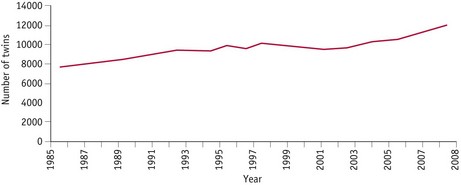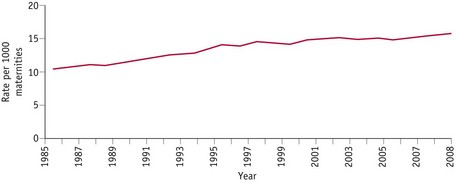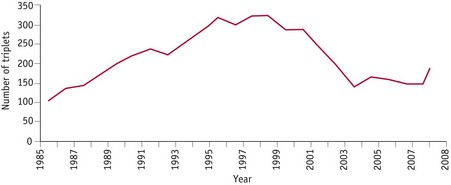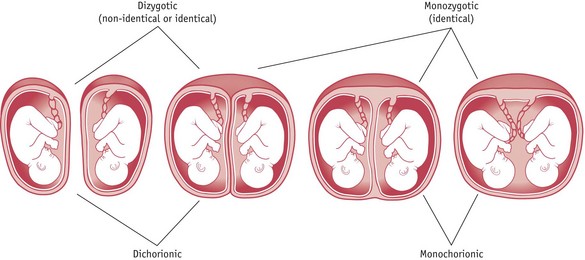Chapter 59 Multiple pregnancy
The Incidence of Multiple Births
The incidence of multiple births continues to rise, mainly because of the increased availability of treatments for infertility (Kurinczuk 2006). A decline in the 1970s was followed by a rise from the early 1980s onwards (Fig. 59.1) (MacFarlane & Mugford 2000). In the UK, the multiple birth rate in 2008 was 15.48 per thousand maternities (Fig. 59.2). A total of 11,573 sets of twins and 149 sets of triplets were born (Fig. 59.3).

Figure 59.1 Twinning rate in UK 1985–2008.
(Source: ONS London, GRO Northern Ireland and GRO Scotland.)

Figure 59.2 Multiple births in England and Wales, 1985–2008.
(Source: ONS, Birth Statistics, Series FM1.)
Multiple pregnancies carry higher risks for the mothers and babies, and can impose a greater burden practically, financially and emotionally on the parents (Botting et al 1990) and also on neonatal services (Collins & Graves 2000).
If a dead fetus is delivered with a live birth after 24 weeks’ gestation, it should be registered as a stillbirth even if death occurred much earlier in the pregnancy (MacFarlane & Mugford 2000).
Facts about multiples
How twins arise
There are two types of twins: monozygotic and dizygotic.
Causes of twinning
The cause of monozygotic twinning is unknown, but recent reports suggest that slightly more are born after the use of drugs to stimulate ovulation and assisted conception procedures. The incidence of MZ twins throughout the world was approximately 3.5–4 per 1000 until the recent slight rise which may be associated with fertility treatments (Derom et al 2001).
Dizygotic twinning is different as there are several known associated factors (Chitayat & Hall 2006): maternal age, parity, race, maternal height and weight, and infertility treatments.
Determination of zygosity
Zygosity determination means finding out whether or not twins, triplets or more are monozygotic (identical). Midwives should understand the importance of this for the clinical care of the mothers and babies, so that it is not incorrectly assumed that, if the babies are the same sex and dichoronic, they are necessarily dizygotic (non-identical) (see placentation above). Accurate information about zygosity and how it can be determined should be provided as soon as a multiple pregnancy is diagnosed.
Placentation
There can be two separate placentas (dichorionic) or a single placenta (monochorionic), which can sometimes be fused (dichorionic) (Fig. 59.4). All dizygous twins have dichorionic (two chorions) and diamniotic (two amnions) placentas (DCDA).
About one-third of monozygous twins also have DCDA placentas; this arises if the embryo divides within the first 3 or 4 days after fertilization, before implanting in the uterus. In about two-thirds of cases, the division occurs between 4 and 8 days and this placenta will be monochorionic diamniotic (MCDA). Monoamniotic twins (MCMA) occur in about 1% of cases and arise when the embryo divides later, between 9 and 12 days.
Despite the now well-established facts about placentation and zygosity, many parents are still told incorrectly that if same-sex twins are dichorionic they must be non-identical.
Importance of chorionicity
When a twin pregnancy is diagnosed on ultrasound scan, an assessment of the chorionicity should be made (preferably during the first trimester) by measuring the thickness of the dividing membranes (Fisk & Bryan 1993). Nearly all monochorionic placentas have blood vessels linking the placenta together. As long as the bloodflow can pass in both directions, there will not be a problem; however, if anastomoses occur between an artery and a vein, causing the blood to flow in one direction only, twin-to-twin transfusion syndrome is likely to occur. This happens in approximately 15% of MCDA twins.
Diagnosis of a multiple pregnancy
Ultrasound examination
Ultrasound screening may be carried out as early as 6 weeks into the pregnancy and most women are aware of the multiple conception by 20 weeks. When the diagnosis is made in the first trimester, the risk of the ‘vanishing twin syndrome’ should be explained (Landy & Nies 1995). Chorionicity should be determined in the first trimester.
Inspection
A midwife must always be alert to the possibility of twins if, on inspection, the uterus looks larger than expected for the gestation, especially after 20 weeks, and fetal movements are seen over a wide area, although the diagnosis need not always be of twins. A history of twins in the family should also be taken into account.
Palpation
On abdominal palpation, the fundal height may be greater than expected for the period of gestation.
If two fetal poles (head or breech) are felt in the fundus of the uterus and multiple fetal limbs are palpable, this may be indicative of a multiple pregnancy. A smaller-than-expected head for the size of the uterus may suggest that the fetus is small and there may be more than one present. Location of three poles is diagnostic of at least two fetuses.
Auscultation
Hearing two fetal heart rates is not diagnostic of a twin pregnancy, as one heart rate can be heard over a wide area. The use of ‘Sonicaid’ machines in monitoring fetal heartbeats has improved detection of more than one fetal heart rate, but heartbeats must be listened to simultaneously for at least 1 minute. If the two heartbeats have a variation of more than 10 beats per minute, almost certainly twin infants are present.
Antenatal screening
The UK National Screening Committee standard for screening in multiple pregnancy is by measurement of nuchal translucency (NT), preferably in combination with biochemistry. Biochemical screening alone should not be used.
Chorionic villus sampling (CVS) can be performed from the 11th week and has a 3–4% risk of miscarriage in a multiple pregnancy. Amniocentesis can also be performed in twin pregnancies, usually between 15 and 20 weeks. The risk of miscarriage is 2.5%. Both tests should be performed in a specialist fetal medicine centre.
Antenatal preparation
Early diagnosis of multiple pregnancy and chorionicity is extremely important so that parents have the additional specialist support and advice they need.
At whatever stage parents are told, it is essential that whoever shares the news is aware of the effect the revelation may have. Although some mothers and fathers are delighted to know that more than one baby is expected, in many cases there are reactions of shock and disbelief (Spillman 1986). It is important that an obstetrician or midwife is available to answer questions and give appropriate counselling at this time. It is helpful if the mother can be put in touch with other parents of twins who can understand and provide reassurance. Contact numbers for local twins groups and information about other relevant support organizations can be a great source of reassurance (see website).
Parent education
As soon as a multiple pregnancy is diagnosed, written information should be given containing contact numbers of the local twins club, the parent education department at the local hospital, and national twin organizations, such as The Multiple Births Foundation (MBF) and The Twins and Multiple Births Association (Tamba). The news that two babies are expected can come as a considerable shock to some families, and the midwife should give them every opportunity to discuss any concerns they have.
Routine parentcraft classes need to be booked as early as possible; ideally, the mother should commence these at 24 weeks’ gestation, which is earlier than for a singleton pregnancy, or specialist multiple pregnancy classes at 28 weeks (Davies 1995). When planning classes, contact with the local twins club can provide a very useful source of practical information. Mothers from twins clubs are usually delighted to participate and offer practical information, such as on equipment, clothes and breastfeeding (Denton & Bryan 1995).
Midwives must be aware of the enhanced role of fathers in the care of multiples and their cooperation in the mother’s care should be sought from the start.
Preparation for breastfeeding
Mothers expecting twins or triplets will inevitably give a lot of thought to how they are going to feed their babies, not only from the nutritional aspect but also from the practical one because feeding will take a large part of the first months. Mothers should be encouraged that breastfeeding not only is possible for two babies and in some cases three (Fuducia 1995), but can be a very rewarding experience for all. Breast milk is ideal for all babies and especially important because twins, and more so triplets, tend to be born prematurely and of low birthweight.
Early in the pregnancy the mother should be given as much information about breastfeeding as possible, with contact numbers of local breastfeeding organizations. Both parents should have the chance to talk through any issues; a good idea is to suggest they meet with another mother who is successfully breastfeeding twins (see Davies & Denton 1999).
Complications associated with a multiple pregnancy
When the pregnancy is multiple, minor disturbances are likely to be exaggerated. Morning sickness is often severe and prolonged. Heartburn can be persistent. Increased pressure may cause oedema of the ankles and varicose veins in the legs and vulva. As the pregnancy progresses, dyspnoea, backache and exhaustion are common.
More serious complications

Full access? Get Clinical Tree




